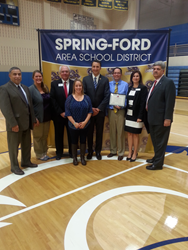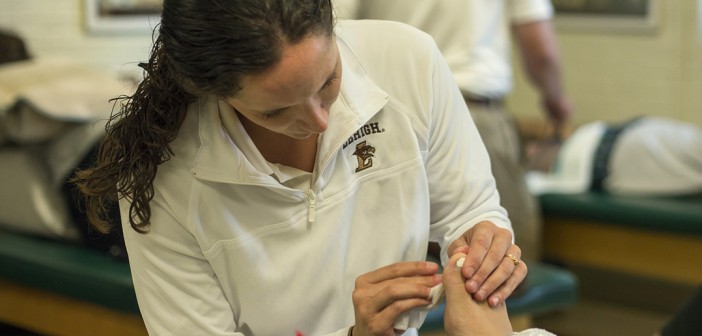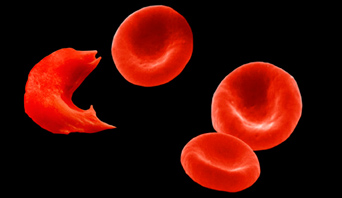
Dr. Bobby Barton has received the highest honor bestowed by the National Athletic Trainers’ Association (NATA).
Barton, of Richmond, professor emeritus in Eastern Kentucky University’s Athletic Training Program, received the prestigious Eve Becker-Doyle Leadership Award at the 66th NATA Clinical Symposia and AT Expo on June 22. Barton has been active in the Association throughout his career, serving in a number of roles, including a position on the board of directors for a number of years and two terms as the Association’s president.
“He created a lot of respect for athletic training while president of the NATA, and he’s done the same at his university over the years,” said Joe Gieck, former director of sports medicine and professor of clinical orthopaedic surgery at the University of Virginia.
During his time as NATA president, Barton oversaw the creation of the NATA Research and Education Foundation, which raises funds and supports research in athletic training. Barton said that prior to its formation, very little of the research being done was by athletic trainers on the field with athletes on a daily basis.
Barton also served on the NATA Placement Committee, Public Relations Committee and Research and Education Board of Directors. Prior to becoming the association’s president, Barton served as NATA’s District IX Director and NATA vice president.
He was inducted into the NATA Hall of Fame in 1996, and the Southeast Athletic Trainers’ Association named a scholarship after him.
“There is no person who [better] embodies all that is good about all of us than Bobby Barton,” said Chuck Kimmel, director of the injury clinic at Appalachian State University. “It is only fitting that a person who has made thousands of people’s lives better is being honored.”
The Eve Becker-Doyle Leadership Award is the highest honor given to an NATA member for outstanding leadership and volunteerism within the organization. The award is presented to an athletic trainer who exemplifies leadership and dedication. In order to be eligible for the award, one must be an organization member in good standing and have been a member for 40 years.
Barton became interested in athletic training while growing up in Texas. “As far back as eighth grade, if I had an athletic injury or concern about athletic health, we had a certified athletic trainer in the school district,” he said.
His interest continued through his undergraduate education at the University of Kentucky, during which time he attended his first NATA meeting. “The longer I was around it, the more I liked it,” Barton said. He entered the field of athletic training in 1970, the first year certification was offered by the NATA.
That same year, he earned a master’s degree from Marshall University and, in 1975, he earned a doctoral degree in adapted physical education at Middle Tennessee State. He worked at Marshall, the University of Florida, Florida International University and the University of Kentucky before accepting a position at EKU as athletic trainer and program director.
During his time at the University, Barton served as chair of the physical education department. He was also EKU’s head athletic trainer from 1976 to 2003, including the Colonels’ four-year stretch of football national championship game appearances from 1979 to 1982. The Colonels won titles in 1979 and 1982. Barton was the first athletic trainer inducted into the Ohio Valley Conference Hall of Fame.
Barton also co-authored Kentucky’s legislation on athletic trainer certification, one of the first such laws in the nation. “I think certification definitely raised our level of credibility with the medical community and other allied health professions,” he said.
He was honored with the Distinguished Service Award for Athletic Training from the American Orthopaedic Society for Sports Medicine in 1998 and the Outstanding Football Trainer Award from the All-American Football Foundation in 1999. Barton also served on the American Council on Education’s Commission on College Athletics and as the men’s basketball athletic trainer for the U.S. National Team at the World University Games in 1995.
In addition to the NATA and Ohio Valley Conference Halls of Fame, Barton has been inducted into the Kentucky Athletic Trainers’ Society Hall of Fame and the Marshall University Athletic Hall of Fame.
Though now retired, Barton remains active. “For someone that’s supposedly retired,” said Sheri McNew, sports medicine practice manager in the University of Kentucky’s Department of Orthopaedic Surgery and Sports Medicine, “[Barton] works harder than a lot of people that I know in the athletic training profession, which is truly a credit to what a leader [he is].”
“He is truly a leader,” said Dr. Mary Ireland, associate professor in the University of Kentucky’s Department of Orthapaedic Surgery and Sports Medicine. “I have been blessed to work with several athletic trainers that [Barton has] worked with and trained. They are doing athletic training and also working with us in the clinic, and they do a great job, and great leaders like [Barton] train great individuals like these guys.”
Looking back on his career, Barton said the most rewarding part of athletic training was that he spent most of the workday doing what he liked.
“Forty-eight pretty good years,” he said. “I’ve really enjoyed my association with the entire group.”
ORIGINAL ARTICLE:
http://www.richmondregister.com/community/eku-professor-emeritus-barton-receives-leadership-award/article_35bbf9e8-37a9-11e5-bfa5-7b48613bf37a.html

 See Lynne Young’s full bio.
See Lynne Young’s full bio. What is an Athletic Trainer?
What is an Athletic Trainer? Learn more about Athletic Training.
Learn more about Athletic Training. Read more about the NATA.
Read more about the NATA.







